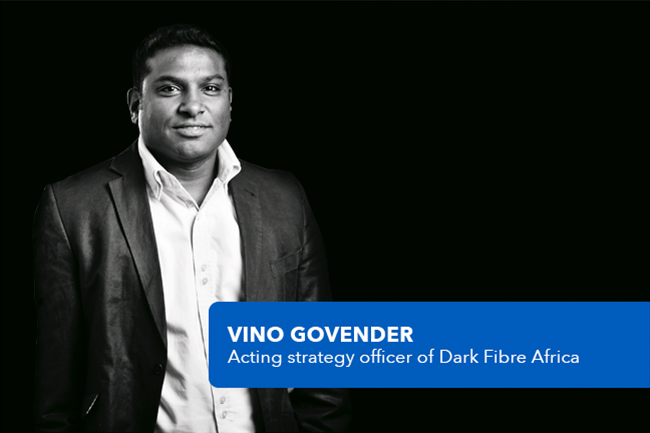Between big data, cloud computing, high-speed fibre connections (fibre-to-the-X or FTTX), the Fourth Industrial Revolution and the blossoming internet of things (IoT), the ICT industry is a thrilling – and often uncertain – place right now. The industry is characterised by rapid evolution and constant disruption. This, says acting chief strategy officer (CSO) of Dark Fibre Africa (DFA) Vino Govender, shifts companies’ focus to adapting and innovating at a rapid pace to remain relevant to both customers and the market as a whole.
As one of Africa’s leading wholesale, open-access fibre players, DFA deals with these evolving technologies every day. But Govender and his team have found one constant amid all this uncertainty: customers. Govender believes their basic requirements can be summed up in three words: simplicity, speed and predictability. ‘Customers want to transact and engage with us in the most simple and frictionless way,’ he says.
‘They want their services and requests attended to quickly and they want to know that the delivery times, service-recovery times and associated service level agreements are repeatable and predictable.’
These constant changes produce an abundance of new opportunities that lie not only within the company’s core area of business but also beyond the core and in adjacent markets. As acting CSO, one of Govender’s challenges is ensuring that the business keeps its focus on the core while at the same time evaluating market adjacencies on which the company can capitalise by leveraging its inherent capabilities.
‘We know that the areas of FTTB [fibre-to-the-business], FTTX and IoT represent high-growth areas in the South African market,’ he says. ‘As a group, we are well structured for all these areas, since DFA focuses on wholesale, open-access FTTB access as well as service provider and carrier core connectivity; SADV [South African digital villages] focuses on wholesale, open-access FTTH connectivity; while SqwidNet focuses on open-access Sigfox IoT connectivity. Within these subsidiaries, innovation, customer experience and operational efficiency remain focal points, which ensure that the businesses remain relevant to their customers and markets. One of the key advantages of having these focused involvements in the market is that we are able to leverage synergies, lessons and capabilities from across these businesses.’
DFA has now laid more than 10 000 km of fibre-optic cables, with coverage in the major metro areas in South Africa. Govender, however, is of the opinion that the geographic footprint alone will not meet future connectivity demand as businesses and consumers increasingly adopt new digital services.
‘We will continue to densify our network to meet the imminent demand from 5G deployment, cloud-based applications and digital services in the business and consumer markets and from the exponential growth from IoT,’ he says. ‘In addition to this, we will increase the extension of the network to small towns and continually look into the African market for international expansion opportunities. DFA Zimbabwe represents the first initiative in this regard.’
To achieve that, DFA relies on a solid, forward-thinking and experienced team that provides visionary leadership and inspires a culture of customer-centricity and innovation. These are integral parts of the operating model of the business. ‘Your attitude, integrity and behaviour must be a reflection of what you want to see in your people,’ he says, reflecting on the type of leadership required in this kind of environment.
‘Self-leadership is the starting point of great leadership – you should not expect to inspire and lead a team of people if you can’t lead yourself first.’ Govender believes that good, effective leaders are those who are able to inspire their teams towards a clear vision that engages them emotionally and with a sense of belief. ‘This means that, even if the leader is not present or when complexities arise, the team is able to navigate these with a clear sense of purpose that is informed by the leader’s vision,’ he says.
‘To achieve this, leaders have to be genuine, honest and transparent with their teams. They need to engage with team members as people, understand their needs, their strengths and their weaknesses, and know how to leverage these to guide them towards achieving the best results, while instilling in them a sense of accomplishment.’
The ICT sector paves the way to a constantly evolving digital world, where end-users will define how they interact, consume and produce goods and services, and experience various facets of life through the use of digital technologies. Govender argues that, rather than fearing these emerging technologies, we should embrace them and the opportunities they present to solve problems. ‘How do we prevent diseases and pandemic outbreaks rather than treat them?’ he asks.
‘How do we manage scarce resources, such as water, soil and energy, and create more sustainable ecosystems in which these can be used more efficiently? We have to shift to solving the root cause rather than treating the symptoms. Digital technologies – including AI [artificial intelligence], the IoT and data analytics – play a critical role in addressing this shift. Reliable, high-speed connectivity is at the core of linking the platforms that enable these technologies to create proactive, root-cause solutions.’
That, says Govender, is the exciting part, ‘knowing that the network and connectivity infrastructure that we build and operate will pave the way for digital innovation and transformation’.



